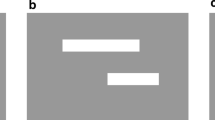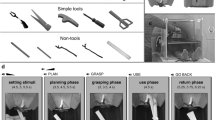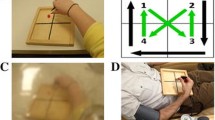Abstract
Humans have remarkable abilities in the dexterous use of tools to extend their physical capabilities. Although previous neuropsychological and functional neuroimaging studies have mainly focused on the contribution of frontal–parietal cerebral networks to skills for tool use, dense anatomical and functional connections are known to exist between the frontal–parietal regions and the lateral cerebellum, suggesting that the cerebellum also supports the information processing necessary for the dexterous use of tools. In this article, we review functional and structural imaging studies reporting that the cerebellum is related to the learning acquisition of neural mechanisms representing input–output properties of controlled objects, including tools. These studies also suggest that such mechanisms are modularly organized in the cerebellum corresponding to the different properties of objects, such as kinematic or dynamic properties and types of tools, and that they enable humans to flexibly cope with discrete changes in objects and environments by reducing interference and combining acquired modules. Based on these studies, we propose a hypothesis that the cerebellum contributes to the skillful use of tools by representing the input–output properties of tools and providing information on the prediction of the sensory consequences of manipulation with the parietal regions, which are related to multisensory processing, and information on the necessary control of tools with the premotor regions, which contribute to the control of hand movements.






Similar content being viewed by others
References
De Renzi E, Lucchelli F. Ideational apraxia. Brain. 1988;111:1173–85.
Ochipa C, Rothi LJ, Heilman KM. Conceptual apraxia in Alzheimer’s disease. Brain. 1992;115(Pt 4):1061–71.
Johnson-Frey SH. The neural bases of complex tool use in humans. Trends Cogn Sci. 2004;8:71–8.
Lewis JW. Cortical networks related to human use of tools. Neuroscientist. 2006;12:211–31.
Iriki A. The neural origins and implications of imitation, mirror neurons and tool use. Curr Opin Neurobiol. 2006;16:660–7.
Clower DM, West RA, Lynch JC, Strick PL. The inferior parietal lobule is the target of output from the superior colliculus, hippocampus, and cerebellum. J Neurosci. 2001;21:6283–91.
Dum RP, Strick PL. An unfolded map of the cerebellar dentate nucleus and its projections to the cerebral cortex. J Neurophysiol. 2003;89:634–9.
Ramnani N. The primate cortico-cerebellar system: anatomy and function. Nat Rev Neurosci. 2006;7:511–22.
Kawato M, Furukawa K, Suzuki R. A hierarchical neural-network model for control and learning of voluntary movement. Biol Cybern. 1987;57:169–85.
Miall RC, Weir DJ, Wolpert DM, Stein JF. Is the cerebellum a Smith predictor? J Mot Behav. 1993;25:203–16.
Wolpert DM, Ghahramani Z, Jordan MI. An internal model for sensorimotor integration. Science. 1995;269:1880–2.
Flanagan JR, Wing AM. The role of internal models in motion planning and control: evidence from grip force adjustments during movements of hand-held loads. J Neurosci. 1997;17:1519–28.
Mehta B, Schaal S. Forward models in visuomotor control. J Neurophysiol. 2002;88:942–53.
Imamizu H et al. Human cerebellar activity reflecting an acquired internal model of a new tool. Nature. 2000;403:192–5.
Imamizu H, Shimojo S. The locus of visual–motor learning at the task or manipulator level: implications from intermanual transfer. J Exp Psychol Hum Percept Perform. 1995;21:719–33.
Raichle ME et al. Practice-related changes in human brain functional anatomy during nonmotor learning. Cereb Cortex. 1994;4:8–26.
Flament D, Ellermann JM, Kim SG, Ugurbil K, Ebner TJ. Functional magnetic resonance imaging of cerebellar activation during the learning of a visuomotor dissociation task. Hum Brain Mapp. 1996;4:210–26.
Kawato M, Gomi H. The cerebellum and VOR/OKR learning models [see comments]. Trends Neurosci. 1992;15:445–53.
Kawato M, Gomi H. A computational model of four regions of the cerebellum based on feedback-error learning. Biol Cybern. 1992;68:95–103.
Shidara M, Kawano K, Gomi H, Kawato M. Inverse-dynamics model eye movement control by Purkinje cells in the cerebellum. Nature. 1993;365:50–2.
Gomi H et al. Temporal firing patterns of Purkinje cells in the cerebellar ventral paraflocculus during ocular following responses in monkeys. I. Simple spikes. J Neurophysiol. 1998;80:818–31.
Kitazawa S, Kimura T, Yin PB. Cerebellar complex spikes encode both destinations and errors in arm movements. Nature. 1998;392:494–7.
Kobayashi Y et al. Temporal firing patterns of Purkinje cells in the cerebellar ventral paraflocculus during ocular following responses in monkeys. II. Complex spikes. J Neurophysiol. 1998;80:832–48.
Moonen C, Bandettini P, editors. Functional MRI. NY: Springer; 2000.
Smith AJ et al. Cerebral energetics and spiking frequency: the neurophysiological basis of fMRI. Proc Natl Acad Sci USA. 2002;99:10765–70.
Aubert A, Costalat R. A model of the coupling between brain electrical activity, metabolism, and hemodynamics: application to the interpretation of functional neuroimaging. Neuroimage. 2002;17:1162–81.
Kida I, Hyder F. Physiology of functional magnetic resonance imaging: energetics and function. Methods Mol Med. 2006;124:175–95.
Hounsgaard J, Yamamoto C. Dendritic spikes in Purkinje cells of the guinea pig cerebellum studied in vitro. Exp Brain Res. 1979;37:387–98.
Hockberger PE, Tseng HY, Connor JA. Fura-2 measurements of cultured rat Purkinje neurons show dendritic localization of Ca2+ influx. J Neurosci. 1989;9:2272–84.
Ito M, Sakurai M, Tongroach P. Climbing fibre induced depression of both mossy fibre responsiveness and glutamate sensitivity of cerebellar Purkinje cells. J Physiol Lond. 1982;324:113–34.
Doi T, Kuroda S, Michikawa T, Kawato M. Inositol 1,4,5-trisphosphate-dependent Ca2+ threshold dynamics detect spike timing in cerebellar Purkinje cells. J Neurosci. 2005;25:950–61.
Tanaka K et al. Ca2+ requirements for cerebellar long-term synaptic depression: role for a postsynaptic leaky integrator. Neuron. 2007;54:787–800.
Kuroda S, Schweighofer N, Kawato M. Exploration of signal transduction pathways in cerebellar long-term depression by kinetic simulation. J Neurosci. 2001;21:5693–702.
Tanaka K, Augustine GJ. A positive feedback signal transduction loop determines timing of cerebellar long-term depression. Neuron. 2008;59:608–20.
Ogasawara H, Kawato M. Bistable switches for synaptic plasticity. Sci Signal. 2009;2:pe7–7.
Sakurai M. Synaptic modification of parallel fibre–Purkinje cell transmission in vitro guinea-pig cerebellar slices. J Physiol Lond. 1987;394:463–80.
Wang X, Chen G, Gao W, Ebner T. Long-term potentiation of the responses to parallel fiber stimulation in mouse cerebellar cortex in vivo. Neuroscience. 2009;162:713–22.
Kano M, Rexhausen U, Dreessen J, Konnerth A. Synaptic excitation produces a long-lasting rebound potentiation of inhibitory synaptic signals in cerebellar Purkinje cells. Nature. 1992;356:601–4.
Mittmann W. Feed-forward inhibition shapes the spike output of cerebellar Purkinje cells. J Physiol. 2004;563:369–78.
Brunel N, Hakim V, Isope P, Nadal J-P, Barbour B. Optimal information storage and the distribution of synaptic weights perceptron versus Purkinje cell. Neuron. 2004;43:745–57.
Mittmann W, Hausser M. Linking synaptic plasticity and spike output at excitatory and inhibitory synapses onto cerebellar Purkinje cells. J Neurosci. 2007;27:5559–70.
Canals S, Beyerlein M, Merkle H, Logothetis NK. Functional MRI evidence for LTP-induced neural network reorganization. Curr Biol. 2009;19:398–403.
Ogasawara H, Doi T, Doya K, Kawato M. Nitric oxide regulates input specificity of long-term depression and context dependence of cerebellar learning. PLoS Comput Biol. 2007;3:e179.
Akgoren N, Fabricius M, Lauritzen M. Importance of nitric oxide for local increases of blood flow in rat cerebellar cortex during electrical stimulation. Proc Natl Acad Sci USA. 1994;91:5903–7.
Imamizu H, Kuroda T, Miyauchi S, Yoshioka T, Kawato M. Modular organization of internal models of tools in the human cerebellum. Proc Natl Acad Sci USA. 2003;100:5461–6.
Wolpert DM, Kawato M. Multiple paired forward and inverse models for motor control. Neural Netw. 1998;11:1317–29.
Haruno M, Wolpert DM, Kawato M. Mosaic model for sensorimotor learning and control. Neural Comput. 2001;13:2201–20.
Milner TE, Franklin DW, Imamizu H, Kawato M. Central control of grasp: manipulation of objects with complex and simple dynamics. Neuroimage. 2007;36:388–95.
Shadmehr R, Holcomb HH. Neural correlates of motor memory consolidation. Science. 1997;277:821–5.
Rabe K et al. Adaptation to visuomotor rotation and force field perturbation is correlated to different brain areas in patients with cerebellar degeneration. J Neurophysiol. 2009;101:1961–71.
Krakauer JW, Ghilardi MF, Ghez C. Independent learning of internal models for kinematic and dynamic control of reaching. Nat Neurosci. 1999;2:1026–31.
Flanagan JR et al. Composition and decomposition of internal models in motor learning under altered kinematic and dynamic environments. J Neurosci. 1999;19:RC34.
Higuchi S, Imamizu H, Kawato M. Cerebellar activity evoked by common tool-use execution and imagery tasks: an fMRI study. Cortex. 2007;43:350–8.
Grodd W, Hulsmann E, Lotze M, Wildgruber D, Erb M. Sensorimotor mapping of the human cerebellum: fMRI evidence of somatotopic organization. Hum Brain Mapp. 2001;13:55–73.
Imamizu H, Higuchi S, Toda A, Kawato M. Reorganization of brain activity for multiple internal models after short but intensive training. Cortex. 2007;43:338–49.
Krakauer JW et al. Differential cortical and subcortical activations in learning rotations and gains for reaching: a PET study. J Neurophysiol. 2004;91:924–33.
Graydon FX, Friston KJ, Thomas CG, Brooks VB, Menon RS. Learning-related fMRI activation associated with a rotational visuo-motor transformation. Brain Res Cogn Brain Res. 2005;22:373–83.
Quallo MM et al. Gray and white matter changes associated with tool-use learning in macaque monkeys. Proc Natl Acad Sci USA. 2009;106:18379–84.
Della-Maggiore V, Scholz J, Johansen-Berg H, Paus T. The rate of visuomotor adaptation correlates with cerebellar white-matter microstructure. Hum Brain Mapp. 2009;30:4048–53.
Kamitani Y, Tong F. Decoding the visual and subjective contents of the human brain. Nat Neurosci. 2005;8:679–85.
Miyawaki Y et al. Visual image reconstruction from human brain activity using a combination of multiscale local image decoders. Neuron. 2008;60:915–29.
Toda A, Imamizu H, Kawato M, Sato MA. Reconstruction of two-dimensional movement trajectories from selected magnetoencephalography cortical currents by combined sparse Bayesian methods. Neuroimage. 2011;54:892–905.
Acknowledgements
We would like to thank Miho Onizuka and Nicolas Schweighofer for helpful comments on an earlier version of the manuscript. This research is supported by the Strategic Research Program for Brain Sciences (SRPBS) to MK.
Conflicts of interest
The authors declare that they have no potential conflict of interests.
Author information
Authors and Affiliations
Corresponding author
Rights and permissions
About this article
Cite this article
Imamizu, H., Kawato, M. Cerebellar Internal Models: Implications for the Dexterous Use of Tools. Cerebellum 11, 325–335 (2012). https://doi.org/10.1007/s12311-010-0241-2
Published:
Issue Date:
DOI: https://doi.org/10.1007/s12311-010-0241-2




